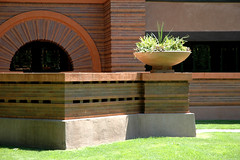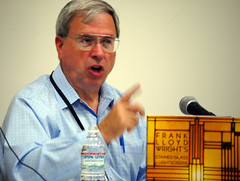Thomas A. Heinz AIA speaking at the Printers Row Book Fair about the fact that 3 Million people visit Frank Lloyd Wright structures every year.
One of the best parts about hearing Thomas Heinz speak about his new book, the Frank Lloyd Wright Field Guide, at the book fair over the weekend was the way he shared his research notes about the people who lived in these houses.
The field guide is notable because it organizes all of the existing domestic and international FLW structures geographically, and with GPS codes (along with street addresses) so that they’re easy to find. He also annotates them with relevant notes so you can decide whether you want to bother finding them.
Each house is named after its original owner, of course, and includes notes about the history of its commission and, where relevant, its evolution. Here’s an example from the Roland Reisley House in Pleasantville, NY (GPS N 41 07.418 // W 73 44.695, if you’re wondering):
The clients were a physicist who married a psychologist in 1950, both only children. When they were looking for a place to start a family, they took a look at this cooperative and liked it.The fact that Heinz manages to maintain this kind of historical annotation for what appears to approach over 500 listings is a pretty impressive accomplishment in itself.
On 26 October 1950 they sent a five-page letter to Mr. Wright outlining their needs and the $20,000 budget. Wright suggested a meeting, and the Reisleys drove to Taliesin. They got the preliminary drawings in February 1951 but Wright noted the budget now at $30,000, to their surprise.
Wright, then 84, visited Usonia and spent time with them on their site. Excavation began on September 1951, and they moved in in June 1952 although it was a bit unfinished. In the mid-1950s an addition was planned and occupied by early 1957, in time for the birth of the Reisleys’ third child.
The story that he told that stuck with me had to do with the Cheneys, the couple who FLW built a house for in Oak Park, IL during the early part of the 20th Century -- before he ran off with Mrs. Cheney in 1909.
The entry in the field guide is fairly dispassionate, simply noting that the house was built, that Mamah Cheney left with Wright for Europe in 1909, and that Mr. Cheney remarried and continued to live in the house until 1926 when he relocated to St. Louis for business.
But Heinz spent some time noodling at these events during the interview on Sunday, wondering: how could Cheney bear to live in that house – its every detail built and designed by Wright -- after his wife left him for the man? And to continue to live there after horror was added to heartbreak when Cheney’s children were murdered, along with his ex-wife, when a domestic servant went postal at Taliesin in 1914?
Heinz had several theories about what might have made it bearable for Cheney, all of them keying into the children who were born or adopted into that house, and the presence of Mamah’s sister Lizzie, who came to stay with them as a Nanny -- and may well have had a child while she was there. (I’ll let you put the pieces together.)
But the anecdote that stopped me in my tracks was learning how in 1914, when Wright received news of Mamah’s death while he was working on a project in Chicago, he got on the first train back to Taliesin -- with Mr. Cheney. Cheney's children had been killed, after all, and he had boarded the same train on his way to collect their remains.
The two men, the story goes, shared a quiet, civil conversation. What they might have said to each other, on a day when the bottom had fallen out of their worlds -- how the two adversaries would have shared, or simply remarked upon their grief, on that slow ride to Wisconsin -- really has me wondering.
p.s. Watch for Heinz on PBS in the coming months – he’s just wrapping up the posthumous construction of a FLW house on Lake Mahopac north of NYC, and PBS showed up with a film crew to capture some of the fun.








No comments:
Post a Comment